HistoryThe city of Philippi was located in northern Greece near the city of Macedon, approximately ten miles from the port city of Neapolis. It gained access to travelers, as well as trade through the Via Egnatia road (the road that linked Italy with Asia), which ran straight through the city. The city had a rather eventful history. Founded in 359 B.C. by the Orator Callistratus, along with a few colonists the city began as a Greek colony. But then came Philip II from the nearby city of Macedon who seized the city and its abundant gold mines. He then proceeded to fortify the city walls, and drain the nearby marshes. He continued to advance the city in many other ways, and then renamed it after himself. When Philip II’s son came to power, Alexander the Great, he used Philippi as a headquarters for his conquest of the world But the second century B.C. brought a dramatic shift in the balance of power in the Grecian world with the invasion of the Romans. With their capture of the province of Macedonia, Philippi became a Roman outpost. With the assassination of Julius Caesar in 42 B.C. civil war broke out in the Roman Empire. Even on this occasion Philippi played a role. It was near the city of Philippi that the forces of Octavian (Augustus) and Mark Antony defeated the forces of Cassius and Brutus. But this comradeship between Octavian and Mark Antony was destined to fail, and war broke out between these two factions as well, with Octavian surmounting as the victor. With his victory complete, Octavian renamed the city of Philippi as Colonia Julia Augusta Philippensis and sent a group of Roman veterans to live there. This influx of Roman soldiers no doubt greatly influenced the culture of Philippi, and by the time Paul entered onto the scene, Philippi had “a strong Roman character”. Barclay (1959) remarks concerning this Roman influence, “Wherever they were, these colonies were little fragments of Rome and their pride in their Roman citizenship was their dominating characteristic. The Roman language was spoken; Roman dress was worn; Roman customs were observed; their magistrates had Roman titles, and carried out the same ceremonies as were carried out in Rome itself. They were stubbornly and unalterably Roman and would never have dreamt of becoming assimilated to the people amidst whom they were set.” Roman citizenship was not something to be taken lightly or for granted. It was to be respected and treasured. Philippi was even further privileged to have the status of a Roman colony. Philippi was one of only five cities in the entire province of Macedonia granted the ius Italicum, which is “the right to be governed by Roman law and to be exempt from direct taxation”. This makes Paul’s statements concerning Roman citizenship all the more important when he addresses the Philippians. Citizenship was a very real, and very vital part of their lives. |
Biblical SignificanceIt is interesting to note that Paul’s first intentions were not to go to the city of Philippi. Acts 16: 7-10 tells the story, “When they came to the border of Mysia, they tried to enter Bithynia, but the Spirit of Jesus would not allow them to. So they passed by Mysia and went down to Troas. During the night Paul had a vision of a man from Macedonia standing and begging him, 'Come over to Macedonia and help us.' After Paul had seen the vision, we got ready at once to leave for Macedonia, concluding that God had called us to preach the gospel to them.” The meager church that Paul found at Philippi was probably founded by converts from his first missionary journey through that region. Upon his arrival he found no synagogue, but only a place of prayer with a few women who called on the name of the God of Abraham, Isaac, and Jacob. Paul quickly began his work in the city, and the first fruit of his labor was the conversion of Lydia, and her household. And it was with her that they stayed during their visit to the city (Acts 16:14-15). It has been suggested that Lydia was a wealthy woman, as she would need a larger home to be able to house Paul and his companions. His stay in Philippi, however, was not without it’s troubles. On one of his trips to the place of prayer, a demon-possessed girl followed Paul and shouted “These men are servants of the Most High God, who are telling you the way to be saved.” She kept this up for several days, until Paul finally got tired of it and cast the demon out of the girl. With the exit of the demon, the girl’s ability to predict the future also evaporated, making the girl’s owners quite upset as they had just lost a good source of income from her fortune telling. The owners then incited an uproar against Paul and his companions. The mob proceeded to grab Paul and Silas and brought them before the magistrate who handed out a sentence of a beating and prison time. This, however, was not properly accomplished according to Roman law, and when the magistrates found out that Paul was a Roman citizen, they quickly recanted and apologized. But Paul was not idle during his time in prison, and succeeded in converting the jailer and his entire family. And so the church began to grow, but with it also grew persecution (Philippians 1:27-30). It is also suggested that “the Philippian Christians must have stuck out like a sore thumb in society. They were not willing to participate in the popular cult of the Roman emperor, nor were they willing to conduct the traditional funerary rites as the graves of their ancestors.” These things would have labeled them “bad citizens” by their friends and family in the city, hence, the greater persecution.
|

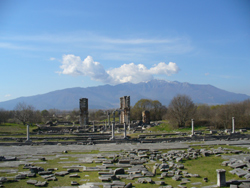
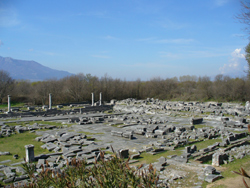
Our first view of the agora at Philippi. Our guide Costas informed us that the Roman agora was not merely a marketplace, but really a town square with religious, commercial and administrative sections. The left photo above contains the Roman temples, the center some of the remains of the shops and the right the administrative or government buildings.
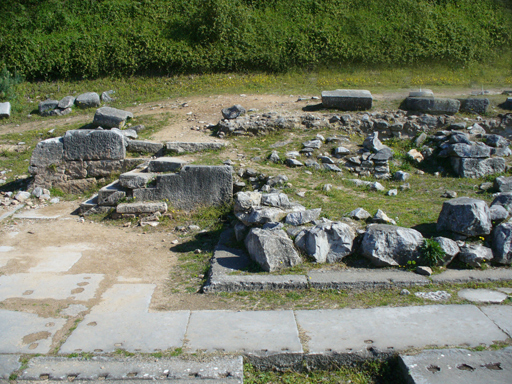 Costas also told us about the bema, a raised platform with steps leading to it. It was used here for the Roman authorities to speak to the people. In front of it punishment of criminals could be carried out. It is possible that Paul and Silas were beaten here since this agora was only 50 or 100 years old at the time of Paul.
Costas also told us about the bema, a raised platform with steps leading to it. It was used here for the Roman authorities to speak to the people. In front of it punishment of criminals could be carried out. It is possible that Paul and Silas were beaten here since this agora was only 50 or 100 years old at the time of Paul.
Not much remains of the platform here, but we can clearly see the steps.
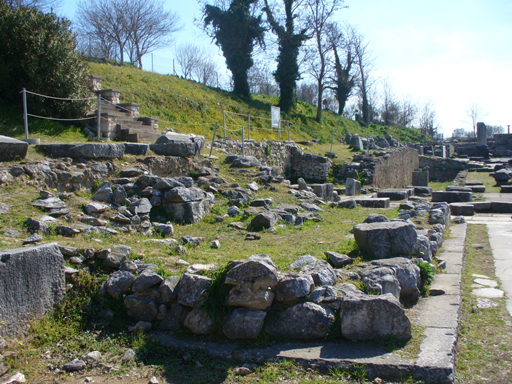 This is where the platform for the bema would have been.
This is where the platform for the bema would have been.
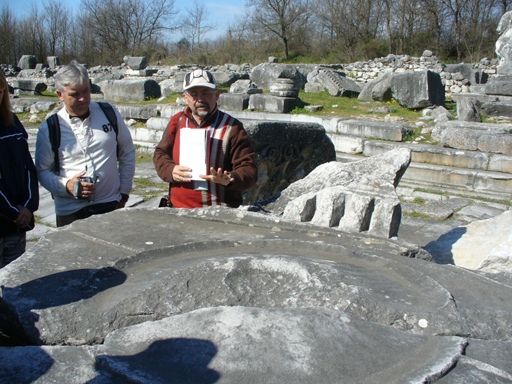 Here Costas shows us a pediment with a shield and sword on it. This shows that this area involved the military or administrative section of the agora.
Here Costas shows us a pediment with a shield and sword on it. This shows that this area involved the military or administrative section of the agora.
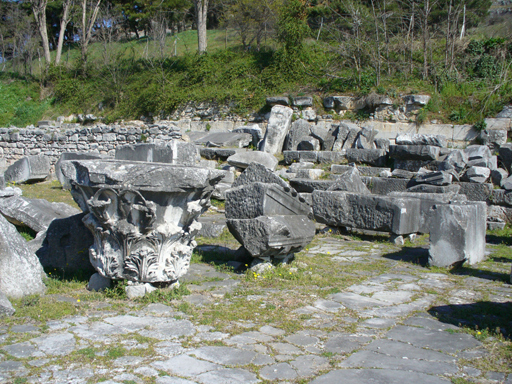 A small part of a pediment in the center, the top of a column to the left and the administrative building in the rear.
A small part of a pediment in the center, the top of a column to the left and the administrative building in the rear.
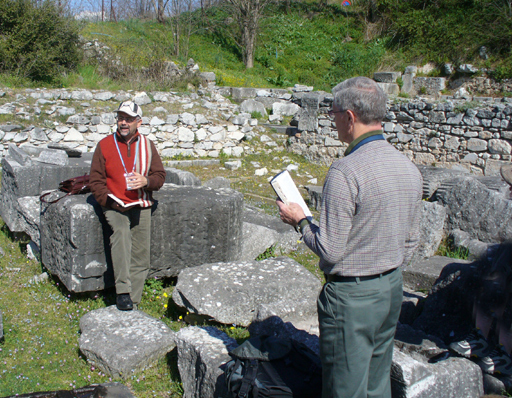 Here we are in what likely was the council chamber in the administrative building where Paul and Silas were brought before the magistrates. Tom then read the passage from Acts 16:19-21
"When the owners of the slave girl realized that their hope of making money was gone, they seized Paul and Silas and dragged them into the marketplace to face the authorities. They brought them before the magistrates and said, 'These men are Jews, and are throwing our city into an uproar by advocating customs unlawful for us Romans to accept or practice."
Here we are in what likely was the council chamber in the administrative building where Paul and Silas were brought before the magistrates. Tom then read the passage from Acts 16:19-21
"When the owners of the slave girl realized that their hope of making money was gone, they seized Paul and Silas and dragged them into the marketplace to face the authorities. They brought them before the magistrates and said, 'These men are Jews, and are throwing our city into an uproar by advocating customs unlawful for us Romans to accept or practice."
It is possible that then they were taken to the bema to be beaten as recorded in Acts 19:22 "The crowd joined in the attack against Paul and Silas, and the magistrates ordered them to be stripped and beaten."
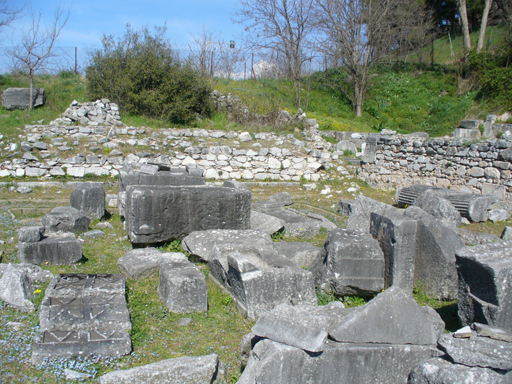 A last look at this administrative area.
A last look at this administrative area.
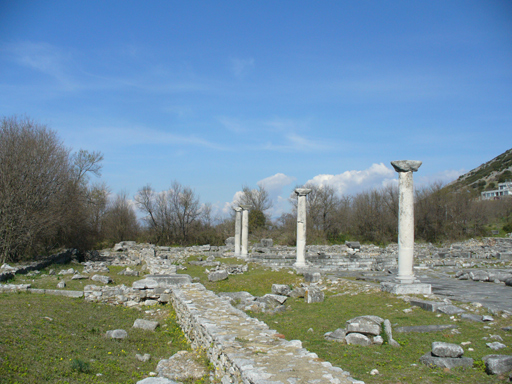 Now we move to the commercial area to see a few columns and the remains of some shops.
Now we move to the commercial area to see a few columns and the remains of some shops.
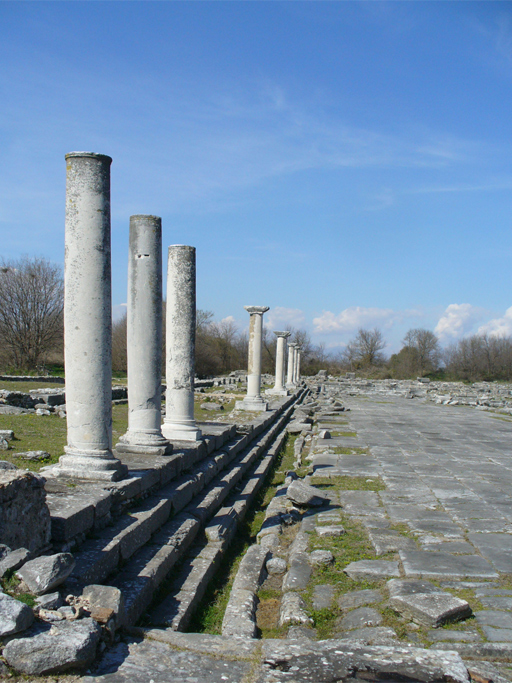 A colonnaded stoa or porch along a marble roadway.
A colonnaded stoa or porch along a marble roadway.
 In this area a church had been built in the 6th century AD. It has had three aisles and a square nave covered by a dome supported by four pillars.
In this area a church had been built in the 6th century AD. It has had three aisles and a square nave covered by a dome supported by four pillars.
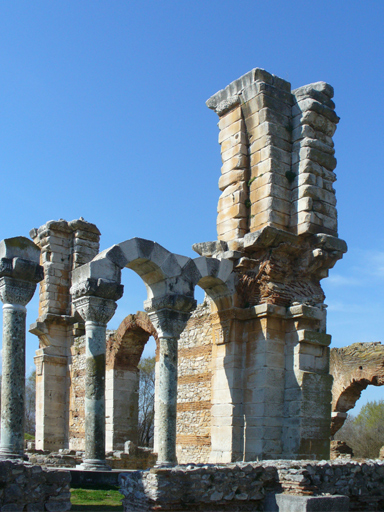
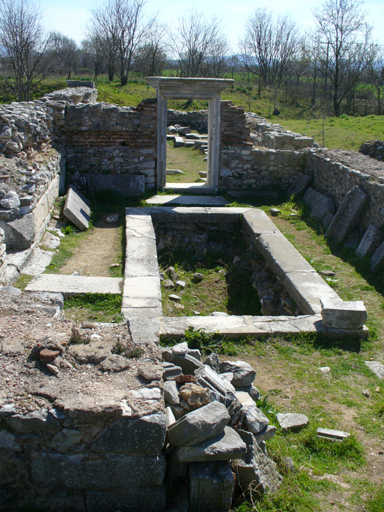 Behind the church was a baptistry.
Behind the church was a baptistry.
 A panoramic shot of the agora.
A panoramic shot of the agora.
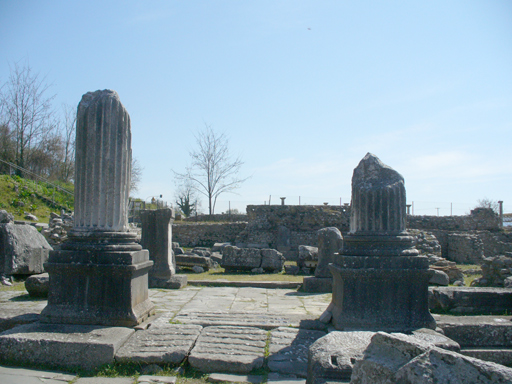 The entrance to a temple. It was here that all citizens were to offer a sacrifice to the Emperor each year to declare their allegiance to him. This presented a problem for Christians and was the cause of much of their persecution.
The entrance to a temple. It was here that all citizens were to offer a sacrifice to the Emperor each year to declare their allegiance to him. This presented a problem for Christians and was the cause of much of their persecution.
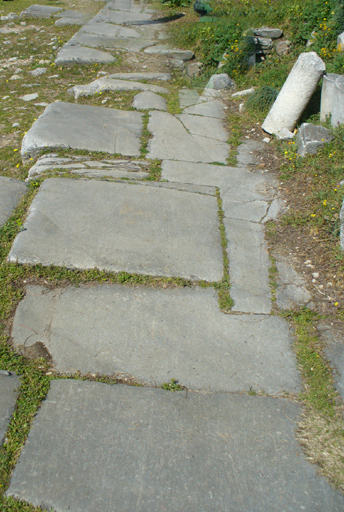 A small section of the Via Egnatia, the main road here in Roman times.
A small section of the Via Egnatia, the main road here in Roman times.
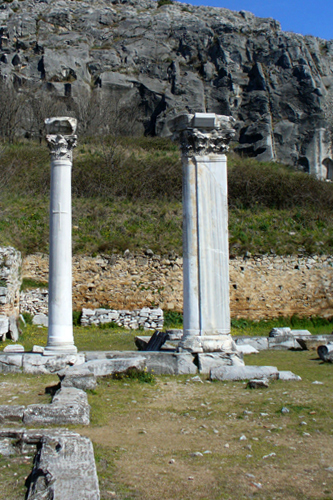 Two columns of a 7th century church. The left one has a cross carved into it.
Two columns of a 7th century church. The left one has a cross carved into it.
 The reconstructed arch leading to the theater. It was through this gate that Christians were singing while being led to their death in the arena.
The reconstructed arch leading to the theater. It was through this gate that Christians were singing while being led to their death in the arena.
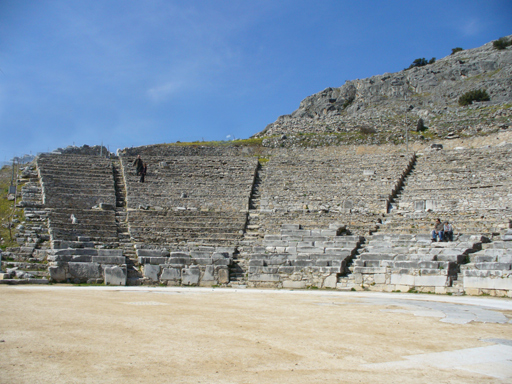 The theater from the floor.
The theater from the floor.
 The theater from below.
The theater from below.
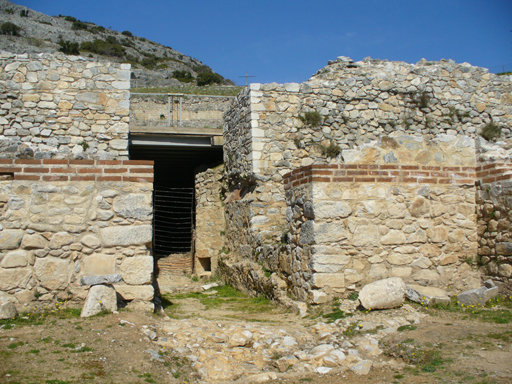 The lions would be taken up this ramp into the arena to kill the Christians.
The lions would be taken up this ramp into the arena to kill the Christians.
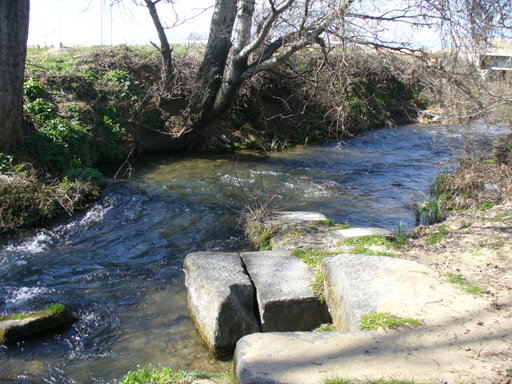 Ater lunch at a festival being held nearby, we were taken to the river where Lydia was baptized by Paul.
Ater lunch at a festival being held nearby, we were taken to the river where Lydia was baptized by Paul.
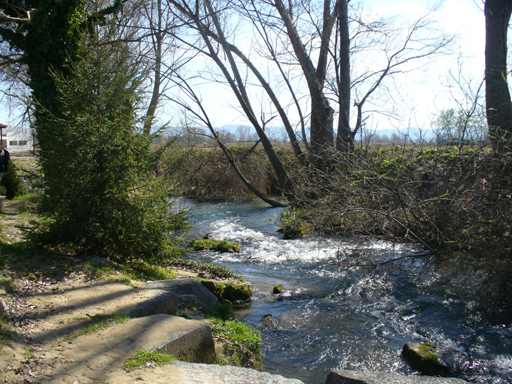
 Nearby was a small church.
Nearby was a small church.
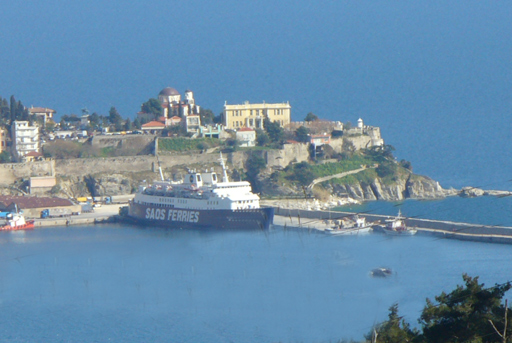 We stopped for a view of present-day Kavala, the port which was called Neapolis in Paul's time. It was here that he landed after sailing from Troas.
We stopped for a view of present-day Kavala, the port which was called Neapolis in Paul's time. It was here that he landed after sailing from Troas.
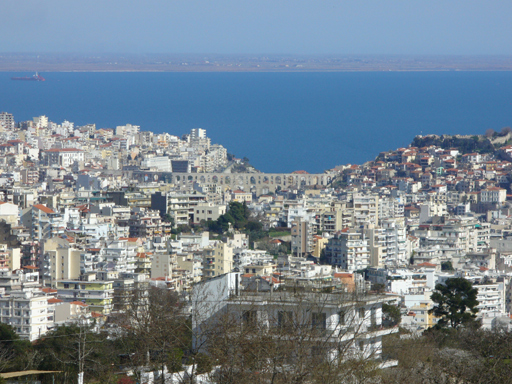 In another view of Kavala we can see the Roman aqueduct.
In another view of Kavala we can see the Roman aqueduct.
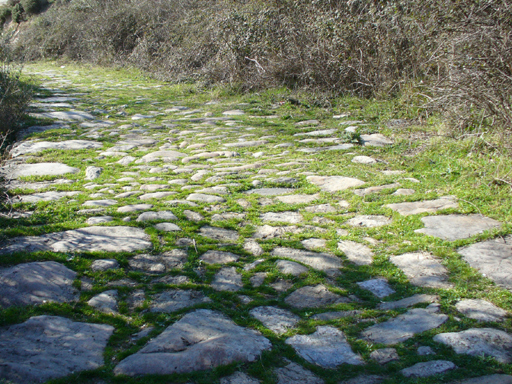 We also saw another section of the Via Egnatia, the road which Paul traveled when he walked to Thessalonica from Philippi.
We also saw another section of the Via Egnatia, the road which Paul traveled when he walked to Thessalonica from Philippi.
After returning to Thessalonica for the night we went to Berea.
